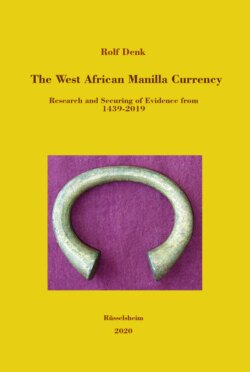Читать книгу The West African Manilla Currency - Rolf Denk - Страница 9
На сайте Литреса книга снята с продажи.
Оглавление3 Excerpts from former Portuguese merchant ship’s books
It can be assumed that since 1485 at the latest, the Portuguese had known the shipping route from the Bay of Benin through the Niger Delta, the Niger, and the River Forcados88 to the city of Benin (Maps 10, 11, 12, 13) (Ryder 1959). In Benin, slaves were bought and shipped from there via São Tomé, later directly to São Jorge da Mina (Elmina in Ghana). This trade was firmly in Portuguese hands, temporarily subordinated directly to the Crown, temporarely delegated to the royal governors of São Tomé and Principe, as already mentioned in the previous chapter (Pacheco Pereira). Manillas were an essential means of payment for slave acquisition whereby the Bini preferred those made of copper to those made of brass.
1) Ship's book of the São Miguel 1522 shipping from São Tomé to Benin (Ryder 1965a: 20, no. 29, Ryder 1969:295, Teixeira da Mota & Mauny 1978, Elbl 1984:403):
First, the order is noted that in no case more than 50 manillas (bracelets de cuivre) may be paid for the best slave (piece, peça; the slave is considered a trade piece, Ryder 1969:295 n2). Infringements lead to wage cuts.
A list for each trade process is made in which can be seen how many manillas can be paid for elephant teeth, coris (possibly aggry geads), slaves, yams, wood, water, and special services. According to Teixeira da Mota and Mauny’s texts, the expenses amount to 5,891 (according to Elbl only 5,739) manillas. Of these, according to Ryder (1969:301 n1), just 3,750 manillas were needed for the acquisition of 189 elephant teeth (an average of 20 manillas for one tooth). Ryder and Teixeira da Mota & Mauny have no information on the weight and material of the manillas. Elbl (1986) writes “copper manillas”. Only the original text, which is not accessible to me, would bring clarity.
2) The Samta Maria da Comçeçam (Santa Maria Conceição) ship’s log of the 1522 voyage from São Tomé to Benin (Ryder 1959; Ryder 1965a: 18, no.20; Brásio 1965; Mauny 1967; Elbl 1984:403; Teixeira da Mota 1969a: 15). The records show that a total of 4,010 copper manillas belonged to the cargo. From these, 19 elephant teeth were bought for 261 manillas, 3,973 coris (aggry?) beads for 796 manillas and 7 slaves for 345 manillas. Further manillas were used to pay the ship's crew and other helpers’ wages as well as to purchase food and clothing and to pay various fees.
At this point, a footnote from Ryder (1959:316 n2) is also very informative:
Although both cowries and manillas were almost certainly used as currency in the area before the advent of the Portuguese, the stock of manillas was greatly increased from European sources and their purchasing power rapidly declined.
3) The ship Santiago trading voyage from Lisbon to Sierra Leone in 1526 (Teixeira da Mota 1969b, Elbl 1986:400), for which there are records in various documents (Teixeira da Mota 1969b: 537–538). The journey led from Lisbon via the Cape Verde Islands to Sierra Leone (and back). In the estuary and the lower reaches of the Great Scarcies River (Kolenté River or Rio dos Casses, Map 6), 20–30 brass manillas (manilhas de latão) and clothes (côvados de pano) were distributed as gifts in various locations. At the Rio Cacheu in Guinea-Bissau (Map 5) 40–50 brass manillas (manilhas de latão) were paid per slave.
In terms of prices to be paid, brass manillas are mentioned along with tin bracelets (braceletes de estanho) in the same document. (Teixeira da Mota 1969b: 552, 555, 558). In total, 2,345 brass manillas and 1,240 tin bracelets were in the Santiago’s cargo. The Portuguese thus made a clear distinction in the same document between manilhas and braceletes in terms of shape, although both served for paying for indigenous goods on the same occasion.
88 Forcados River (Rio Réal after Hair 1976:25): “[…] a major navigable channel of the Niger Delta. It leaves the main course of the Niger River about 20 miles [32 km] downstream from Aboh and flows through zones of freshwater swamps, mangrove swamps, and coastal ridges before completing its 123 miles [198 km] westerly course to the Bight of Benin.” (see Map 10 from Bouët-Willaumez 1848).
